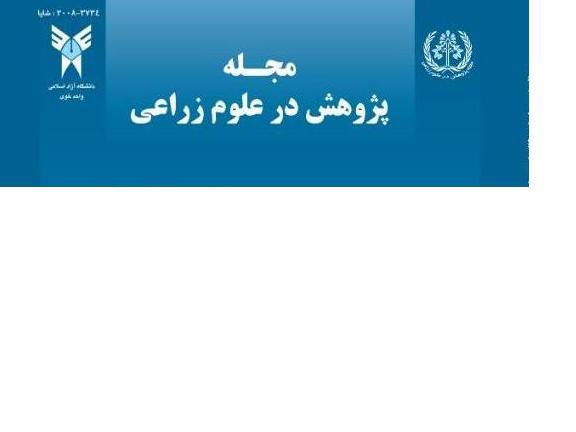بررسی کارائی علفکش جدید کلتودیوم با سایر علفکشهای معمول چغندرقند در کنترل نازک برگ¬ها در شرایط مزرعه
محورهای موضوعی : توليد محصولات زراعي
ناصر جعفرزاده
1
,
حسین نجفی
2
,
سید حیدر موسوی انزابی
3
![]()
1 - محقق و عضو هئیت علمی مرکز تحقیقات و آموزش کشاورزی آذربایجان غربی
2 - استادیار مؤسسه تحقیقات گیاهپزشکی ایران، سازمان تحقیقات،آموزش و ترویج کشاورزی، تهران، ایران
3 - استادیار دانشگاه آزاد اسلامی واحد خوی
کلید واژه: تراکم, علف هرز نازک برگ, عملکرد و كلتوديوم,
چکیده مقاله :
به منظور مقايسه ميزان كارآيي علفکش جدید كلتوديوم (سلکت EC120%) با باريك برگ¬كش¬هاي رايج مزارع چغندر¬قند آزمايشي به مدت دو سال در ایستگاه تحقیقات کشاورزی میاندوآب اجرا شد. در اين بررسي كه در قالب طرح بلوك¬هاي كامل تصادفي در چهار تکرار و هشت تیمار انجام شد، ميزان كارآيي علفكش جديد كلتوديوم با باريك برگكش¬هاي ستوكسيديم (EC%12.5)، هالوكسيفوپپيمتيل(EC%10.8) و پروپاكويزافوب(EC% 10)، علفكش كويزالوفوپ اتيل(EC%5) و شاهد بدون علفهرز مورد ارزيابي قرار گرفت. مقدار و زمان مصرف علفكش¬هاي ثبت شده بر اساس توصيه¬هاي تحقيقاتي و مقدار مصرف علفكش كلتوديوم 40، 80 و 120 سی¬سی در هكتار بود كه در مرحله رشد فعال علف¬هاي هرز باريك برگ (6-4 برگي) اعمال شد. در اين ارتباط تراکم و وزن خشک علف¬هاي هرز غالب و عملكرد چغندر¬قند در هر تيمار تعيين شد. نتایج نشان داد تیمارها اثر معنیداری بر کاهش تراکم و وزن خشک علفهای هرز سوروف (Echinochloa crus-galil)، دمروباهی کشیده (Alopecurus myosuroides) و سورگوم (Sorghum halepense) داشتند. در بین تیمارهای آزمایش علفکش کلتودیوم با میزان 80 سی¬سی در هکتار بهترین گزینه در کنترل علف¬¬های هرز دم روباهی و سوروف بود به طوری که این تیمار تراکم و وزن خشک علفهایهرز مورد مطالعه را به ترتیب، بیش از 70 درصد و 75 درصد کاهش داد. مطلوب¬ترین تيمارها از نظر عملکرد ریشه چغندرقند، علفکش¬های كلتوديوم به مقدار 80 سی¬سی در هكتار (45/ 49 تن در هکتار) و ستوكسيديم به مقدار 3 لیتر در هکتار(90/48 تن در هکتار) بودند.
Anomymous, 2009. View of Agricultural in West Azarbayjan of province.40p.
Ahrens, W.H. 2005. WSSA herbicide handbook, 7th Ed, WSSA. 211 pp.
Andrew, P., Gordener, A., York, D., Jordan, L. and Monks, D.W. 2006. Glufosinate antagonizes post emergence graminicides applied to annual grasses. Cotton Science 10:319-327.
Bazoobandi, M., Bagestani, M.A. and Zand, E. 2006. Weeds and their management in sugar beet fields. Plant pests and diseases research institute press. 80 pp. (In Persian).
Butler, M., Clark, E., McKinley, N., Bohle, M. and Fellows, G. 1995. Sugar beet herbicide evaluation in central Oregon. http://extension.oregonstate. Edu/ Jefferson.
Butler, M. 1996. Evaluation of preemergence and postemergence herbicide applications on sugar beets. http://extension.oregonstate.edu/jefferson/eval96.htm.
Camper, N.D. 1986. Research methods in weed science. Southern Weed Science of America.189 pp.
Clay, D.V., Dixon, F.L. and Willoughby, I. 2006. Efficacy of graminicides on grass weed species of forestry. Crop Protection. 25(9): 1039-1050.
Cemy, L. 2004. A phased graminicide dose and its effect on the degree of sugar beet weed infestation. Listy Cukroramicke Reparske. 116(4):114-115.
Fatemi, H. 1995. The effect of three herbicide on grass weeds in sugarbeet fields in Isfahan. Proceeding of the 12th Iranian Plant Protection Congress. P.137. (In Persian).
Lancaster, S.H., Jordan, D., Johnson, P. and Dewayne, P. 2008. Influence of graminicide formulation on compatibility with other pesticides. Weed Technology. 22(4):580.
Mamnoie, E., Shimi, P. and Bagestani, M.A. 2012. Evaluation of various herbicide efficiency in weed control of seasame (Sesamum indica) in Jiroft and Kohnuj. Journal of Iranian weed Science. 8(2):1-12. (In Persian).
May, M. 1997. Weed control chemical. British Sugar Beet Review. 65:8-12.
Mousavi, M.R. 2010. Integrated weed management. Principles and methods. Marze Danesh Press. 500 pp.( In Persian).
Mosallanezad, H., Noruzian, M. and Mohammadbigi, A. 2007. List of pests, plant diseases and weeds in Iran. Plant Protection organization.112 pp.(In Persian).
Radosevic, J.H. and Ghersa, C. 1996. Weed Ecology. John Wiley and Sons America. 588 pp.
Ransom, C.V., Rice, C.A. and Ishida, J.K. 2002. Sugar Beet Tolerance and Weed Control with Different Herbicide Rates and Timings. Malheur Experiment Station, Oregon State University, Ontario. 98 pp.
Somani, L.I. 1992. Dictionary of weed science. Agronomy Publishing Academy. 256 pp.
Shimi, P., Noruzzadeh, S. and Badaly, K. 2002. Investigation efficacy of Qualizafop- P-Ethyl 5% (Targa super) in sugarbeet fields. Proceeding of the 15th Iranian Plant Proection Congress. P.94. (In Persian).
Shimi, P., Qanbari- Birgani, D., Delgandi, M.R., Qalandar, M. and Fatemi, H. 1998. Investigation the effect of three new graminicide in sugarbeet fields. Proceeding of the 13th Iranian Plant Protection Congress. P.140. (In Persian).
Shimi, P. Abtali, Y., Mousavi, S.K. and Akhavan, M. 2006. Study on efficacy of Haloxyfop-R- Methyl (Galant super 10.8%EC) compared to current graminicide used in oil seed rape (Brassica napus L.) The Proceeding of the 1st Iranian Weed Science Congress. P.398-403. (In Persian).
Tredaway, J.A., Patterson, M.G. and Wehtje, G.R. 2007. Interaction of clethodium with Pyrithiobac and bromoxyil applied in low volume. Weed Technology. 12:185-189.
Wall, D.2005. Flutamone for graminae control in sugar beet. Weed Technology. 6: 878-883.
Vesi., M. Najafi, H. and Jalalilian, A. 2012. Investigation possibility control of Grass weeds in sugarbeet fields with Quizalop –p –tefuryl (Pantera40%Ec). The Proceeding of the 1st Iranian Weed Science Congress. P.117. (In Persian).
Zand, E., Bagestani, M.A., Shimi, P., Nezamzadeh, N. Mousavi, R. and Mousavi, S.K. 2012. Chemical weed control guideline for major crops of Iran.176 pp. (In Persian).

